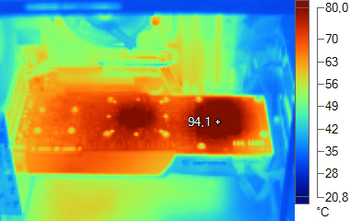OOPS! You forgot to upload swfobject.js ! You must upload this file for your form to work.
NVIDIA vs Radeon thermograph
![]()
|
xtreview is your : Video card - cpu - memory - Hard drive - power supply unit source |
|
|||
|
|
||||
 Recommended : Free unlimited image hosting with image editor
Recommended : Free unlimited image hosting with image editor
|
POSTER: computer news || NVIDIA VS RADEON THERMOGRAPH |
DATE:2009-02-03 |
|
|
Associate used thermograph to measure the heating of different video card sections.
Radeon HD 4850: 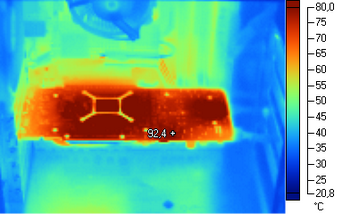 Radeon HD 4870: 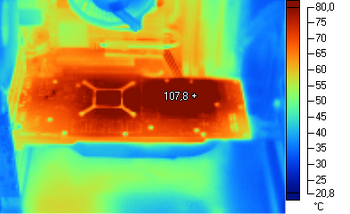 Radeon HD 4870 X2: 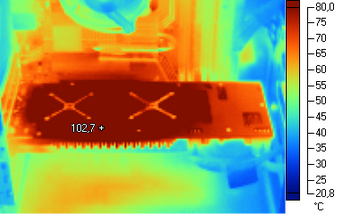 As it is evident, all three cards have a very hot section, with the temperature of approximately 100 degrees Celsius . In the Radeon HD 4850 the power-supply system heats up strongly, and also the region of graphic processor and video memory. The cooling system does not eject hot air outside. In the Radeon HD 4870 most power-supply system region heat up, while the graphic processor zones are colder. However, the GDDR5 memory is completely cool. For the Radeon HD 4870 X2 practically the whole card heats up and the temperature reach more than 100 degrees according to Celsius. Thus, all three cards strongly heat up, and this justifies the red Textolite color . Now let us pass to Nvidia card . GeForce 9800 GTX+: 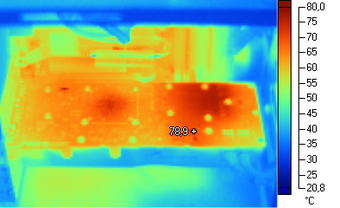 GeForce GTX 260: 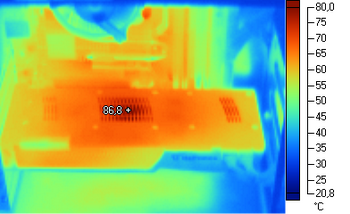 GeForce GTX 285:
GeForce GTX 295: 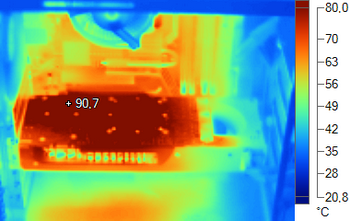 The results Of the GeForce 9800 GTX+ are very different to RV770. The GeForce GTX 260 continues the cold traditions, with heat only in the center : the region of graphic processor positioning. Note here we deal with old version GeForce GTX 260, with the graphic processor GT200, made on 65 NM technological process. The GeForce GTX 285. However, already demonstrates two basic heat centers : graphic processor and the power-supply system, which has the peak temperature of 95 degrees Celsius. The two-chip GeForce GTX 295 practically heat up to 90 degrees Celsius which are up o 10 degrees less than in Radeon HD 4870 X2. The cooling systems of GeForce card manage better their task, and NVIDIA video card have lower operating temperature. Related Products : | ||
|
|
||
|
xtreview is your : Video card - cpu - memory - Hard drive - power supply unit source |
|
|
|
|
||
|
Xtreview Support  N-Post:xxxx Xtreview Support        |
NVIDIA VS RADEON THERMOGRAPH |
| Please Feel Free to write any Comment; Thanks  |
Smartphones and TVs will remain the main consumers of AMOLED panels (2017-07-10)
Toshiba is looking for buyers and businesses for the production of TVs (2017-04-10)
Xenos vs Marines - a new network shooter from Gaijin Entertainment (2017-04-03)
Ryzen 5 1600X 6 core vs Intel Core i5-7600K performance benchmark (2017-02-18)
By 2020, 68 percents of the TVs will be equipped with OLED-displays (2016-12-26)
Sharp will cease to supply panels to Samsung TVs (2016-12-16)
UAVs will be engaged in aerial photography to update Apple Maps (2016-12-02)
Core i7-7700K vs Skylake (2016-10-05)
LeEco preparing to release a new 4K-TVs (2016-08-02)
Eight Radeon R9 290X vs eleven NVIDIA Tesla accelerators (2016-07-23)
Battlefield 1 32 vs 32 gameplay (2016-06-13)
Intel Kaby Lake vs AMD Zen Processors (2016-03-03)
UAVs Google will distribute Internet in the millimeter band (2016-02-01)
At CES 2016 presented smartMask Paintball Empire EVS (2016-01-08)
Samsung TVs will become the center of Internet of things (2015-12-30)
Video card NVIDIA NVS 810e can connect up to eight 4K-monitors (2015-11-05)
Toshiba has introduced 16-crystal stack memory using TSVs (2015-08-07)
Skylake Processor vs Haswell (2015-07-30)
Radeon R9 Fury X voltage vs overclocking (2015-07-28)
AMD will extend VSR support (2015-06-09)
![]()
To figure out your best laptops .Welcome to XTreview.com. Here u can find a complete computer hardware guide and laptop rating .More than 500 reviews of modern PC to understand the basic architecture


7600gt review
7600gt is the middle card range.
We already benchmarked this video card and found that ...

 geforce 8800gtx and 8800gts
geforce 8800gtx and 8800gts  Xtreview software download Section
Xtreview software download Section  AMD TURION 64 X2 REVIEW
AMD TURION 64 X2 REVIEW  INTEL PENTIUM D 920 , INTEL PENTIUM D 930
INTEL PENTIUM D 920 , INTEL PENTIUM D 930  6800XT REVIEW
6800XT REVIEW  computer hardware REVIEW
computer hardware REVIEW  INTEL CONROE CORE DUO 2 REVIEW VS AMD AM2
INTEL CONROE CORE DUO 2 REVIEW VS AMD AM2  INTEL PENTIUM D 805 INTEL D805
INTEL PENTIUM D 805 INTEL D805  Free desktop wallpaper
Free desktop wallpaper  online fighting game
online fighting game  Xtreview price comparison center
Xtreview price comparison center Lastest 15 Reviews


Rss Feeds
Last News
- The new version of GPU-Z finally kills the belief in the miracle of Vega transformation
- The motherboard manufacturer confirms the characteristics of the processors Coffee Lake
- We are looking for copper coolers on NVIDIA Volta computing accelerators
- Unofficially about Intels plans to release 300-series chipset
- The Japanese representation of AMD offered monetary compensation to the first buyers of Ryzen Threadripper
- This year will not be released more than 45 million motherboards
- TSMC denies the presentation of charges from the antimonopoly authorities
- Radeon RX Vega 64 at frequencies 1802-1000 MHz updated the record GPUPI 1B
- AMD itself would like to believe that mobile processors Ryzen have already been released
- AMD Vega 20 will find application in accelerating computations
- Pre-orders for new iPhone start next week
- Radeon RX Vega 57, 58 and 59: the wonders of transformation
- ASML starts commercial delivery of EUV-scanners
- The older Skylake processors with a free multiplier are removed from production
- Meizu will release Android-smartphone based on Helio P40
- AMD Bristol Ridge processors are also available in American retail
- The fate of Toshiba Memory can be solved to the next environment
- duo GeForce GTX 1080 Ti in GPUPI 1B at frequencies of 2480-10320 MHz
- New Kentsfield overclocking record up to 5204 MHz
- Lenovo released Android-smartphone K8

HALO 3 HALO 3 - Final Fight!

PREY Prey is something you don t often see anymore: a totally unigue shooter experience.

computer news computer parts review Old Forum Downloads New Forum Login Join Articles terms Hardware blog Sitemap Get Freebies

